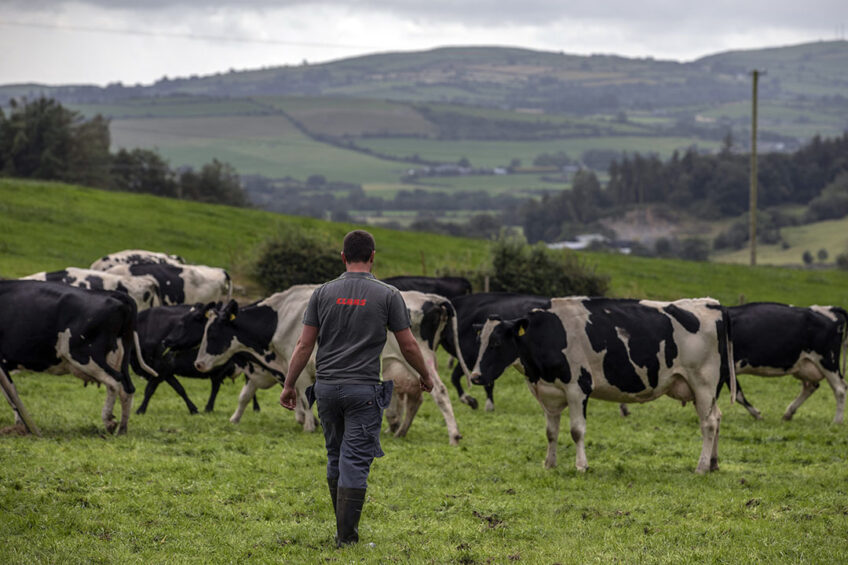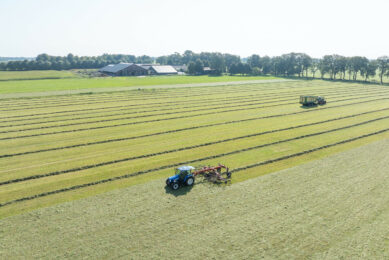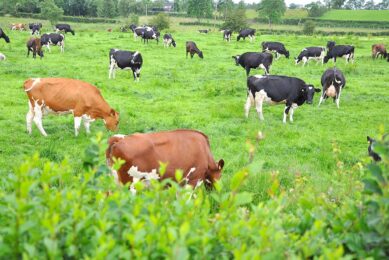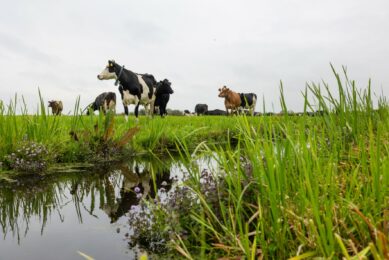Increase pasture use: Steps to success

Here we dive into the latest findings on how to increase use of pasture and explore and face the challenges that come with it – while protecting milk quantity and quality. We hear from experts around the world.
Use of pasture can provide many benefits for dairy farmers across the globe. For example, milk quality attributes such as health and naturalness associated with pasture-based feeding systems “are recognised by discerning consumers and are being exploited by producer groups and supermarket chains” note scientists at the University of Bristol and University of Nottingham in England, who published an extensive analysis of pasture use in December 2019. Professor Marcia Endres at the University of Minnesota in the US adds that while only 5–8% of lactating dairy cattle across the US are on pasture, this may increase due to increased consumer interest in “grass-fed” milk, which pays a premium.

Benefits of using pasture also include positive public perception of dairy farming. For example, “a study conducted at the University of British Columbia [UBC] showed that Canadian citizens view outdoor access as an important element for dairy cow welfare,” notes Dr Anne-Marieke Smid, a postdoctoral researcher at the University of Calgary in Alberta, Canada. “With colleagues, I have investigated the preference of free-stall housed dairy cattle for different types of outdoor access during my PhD at UBC. We found that cows spent 90% of the night on pasture, when given the opportunity.”
…a study conducted at the University of British Columbia [UBC] showed that Canadian citizens view outdoor access as an important element for dairy cow welfare.”
Pasture use is also easy on the planet because it relies solely or mainly on grass growth instead of growing and/or transporting other crops for feed. In addition, depending on management skill and other individual farm factors, it can of course make milk production more cost-effective. Indeed, milk production in Brazil is focused on pasture use because of its low cost. In addition, this year “with great uncertainty for dairy farmers due to the coronavirus pandemic,” according to the College of Agriculture, Food and Rural Enterprise in Northern Ireland, “it is important to make the maximum use of grazed grass to produce milk at lower cost.”
While the benefits and opportunities of pasture use are numerous, it seems difficult for many dairy farmers to increase their use of pasture. Pasture use is not feasible, for example, if there are too many cows and limited space, or in parts of the world such as Canada, which has months of heavy rain or snow/cold. Indeed, Dr Smid and her colleagues found that only about 30% of Canadian farms provide lactating cows with access to pasture, and a little less than 60% of Canadian farmers pasture their dry cows. She and her colleagues are currently conducting focus groups of Western Canadian dairy farmers to understand their motives when using pasture or other types of outdoor areas on their farm and their perceived barriers related to improving outdoor access.

Pasture use challenges
There are still other barriers preventing dairy farmers from seizing the benefits of pasture use (recently listed by the team at the University of Bristol and University of Nottingham), including variable and unpredictable grass growth, low daily grass intake, lower milk output and lower nitrogen (N) use efficiency (more N excretion). However, these scientists note that “opportunities exist to develop novel approaches to grazing management to meet these challenges, including the application of automated techniques for monitoring grazing behaviour and pasture allocation”. They add that “developments in plant breeding also provide potential routes to improve animal performance”. Also, grass intake may be boosted through the use of certain grass species with higher dry matter (DM) or improved digestibility.
A next step in the search towards sustainable grazing is to explore the value of different mixtures of grasses, legumes and herbs.”
Steps to success
In the end, success in achieving good levels of grass intake and milk production is very much about synchronising grass supply with the nutritional demands of the cow, but this is easier said than done. Both change throughout the season and can depend on geographical location, yearly weather patterns and cow genetics. Use of pasture, like many aspects of farming, therefore takes time to get good at and presents different scenarios every year.
Among others, experts at the College of Agriculture, Food and Rural Enterprise in Northern Ireland believe grass height of 8–10 cm is ideal for dairy cows in a rotational grazing system (paddocks or strip-grazing). This height can sustain a high level of milk production with good compositional quality. In spring, grass should only be grazed after the third-leaf stage because before then the plant does not have enough reserves to regrow after being trimmed by cows.
To continually measure pasture height/mass, farmers can use a rising plate meter, cut-and-weigh or visual assessment. Some farmers can also access high-tech tools that forecast pasture growth such as that developed by DairyNZ; this app provides five-day grass growth rate forecasts for various districts of New Zealand.
 Maximise use of grazed grass for cost effective milk production
Maximise use of grazed grass for cost effective milk production
Dairy farmers now, more than ever, must ensure they maximise the use of every square inch of grazed grass to help produce milk at a lower cost.
Fresh grass allowance
To ensure adequate grass intake, the right amount of fresh grass has to be allocated to the herd, and this requires reliable estimation of the fresh grass allowance. Dr Cindy Klootwijk and her colleagues at Wageningen University (WUR) have evaluated the effect of grazing system on rising plate meter calibration to estimate fresh grass allowance and found that one region-specific calibration equation could be used across grazing systems, despite relatively large differences in pre- and post-grazing heights and period of regrowth.
The equation has been calibrated for use in various regions of the world, and Klootwijk notes that the use of such a region-specific equation is critical for farmers since the relationship between grass height and herbage mass is influenced by climate, season, grass variety and soil type. To account for the patches of pasture around manure that are rejected by cows, farmers should exclude the rejected patches from the measurements with the rising plate meter and subtract the percentage of grassland area covered with rejected patches from the total area available for grazing.

Moving cows with technology
In order to move cows around efficiently, balancing their grass intake with the need for the grass to regrow, there are many technological aids now available. “PastureBase Ireland” and INRA (the French National Institute for Agricultural Research), for example, have both developed pasture use tools.
There are also several semi- or fully automated systems that monitor dairy cow grazing behaviour in order to properly allocate pasture and move them according to preset parameters. University of Minnesota researchers recently evaluated the use of an ear-tag accelerometer called CowManager SensOor which requires a number of solar-powered routers placed in the pasture. Prof Endres says the technology can determine a baseline of normal behaviour for individual cows and for the herd. While individual cow alerts could point to health issues or estrus, herd-level behaviour information “could possibly help us decide if cows should be moved to a new paddock,” says Prof Endres, “every 12 hours or every 24 hours.”
Some dairy farmers are also now using virtual fence systems, similar to technologies for pet dogs, to manage movement of pastured cows. The cows wear GPS-enabled collars that keep them in the chosen area or move them along with beeps or if needed, a mild electrical pulse. One called Boviguard was developed in the United Kingdom, and another has been patented by Commonwealth Scientific and Industrial Research Organisation (CSIRO) in Australia. Yet another virtual fence system is being developed at WUR.
 Transitioning to pasture – steps and best practices
Transitioning to pasture – steps and best practices
Dairy Global has gathered thoughts on best practices from experts in several parts of the globe.
High stocking densities
Klootwijk and her colleagues note that dairy farmers have been decreasing the use of grazing in several European countries because of larger herd size, increased milk yield per cow and more robotic milkers. (In the Netherlands, the decreasing trend of grazing is actually reversing nowadays due to societal pressure.) Many farmers with these types of farms, who usually also have high stocking densities on the available grazing area, may not want to try grazing as it might reduce milk yield or have higher labour costs, and they may be uncertain about the practice being worthwhile.
However, in her PhD thesis, Klootwijk found that compartmented continuous grazing (CCG) and strip grazing (SG) can support fresh grass intake of high-yielding dairy cows at high stocking densities on the available grazing area (7.5 dairy cows/ha) without compromising milk production. SG is designed to maximise grass yield but requires a high level of management skills and extra labour to move fences daily; CCG features fixed fencing and less management skill but provides lower grass yield.

Environmental impact
We have already noted that pasture use is environmentally sound because it reduces use of crops and the transport of crops/feed over short or long distances to the farm. Adam Shorten is one dairy farmer with long experience managing pasture use while reducing the environmental impact on his Murragh Farm in Ireland. Shorten was a finalist in the 2019 National Dairy Council & Kerrygold Quality Milk Awards; its entry criteria was recently expanded to include sustainability aspects.
Shorten measures his grass every week and aims for over 1,400kg DM/ha, allowing his cows to graze paddocks to 4cm. He does soil testing and adds appropriate amendments to his pasture as well. Over time, Shorten has extended his grass growth season by using on/off grazing, and among his future plans are adapting clover to pasture swards and obtaining cows bred to be more efficient in grass-based feeding systems.
To help farmers maximise the use of grazed grass while avoiding pasture damage, the Agri-Food and Biosciences Institute in Northern Ireland has issued guidelines. These include walking the grazing platform at least once a week, batching cows, pre-mowing and, during periods of wet weather, adopting a flexible approach that “may involve on/off grazing, allowing cows to graze for a few hours after milking and fed silage when housed”.
Looking forward
It’s clear that while the learning curve for pasture use may be a little steep initially, success can be achieved. Cows must not be permitted to eat spring grass until it’s past the 3rd-leaf stage, and farmers must calculate fresh grass allowance accurately and move their cows appropriately, using technology where possible to save labour.
However, while Klootwijk notes that successful use of pasture is possible even on farms with high stocking density on the grazing area – and can be a valuable first step in reducing supplementary feeding and enabling cows to express natural behaviour – she wonders if it is the route to the future.
On that note, she believes that farmers may be able to increase their use of pasture through reducing feed supplementation, making their cows more motivated to graze. “A lower stocking density relies less heavily on feed supplementation,” she adds, “which can reduce feed–food competition, and may also provide room for biodiversity. A next step in the search towards sustainable grazing is to explore the value of different mixtures of grasses, legumes and herbs to increase the resilience of the grazing system.”










